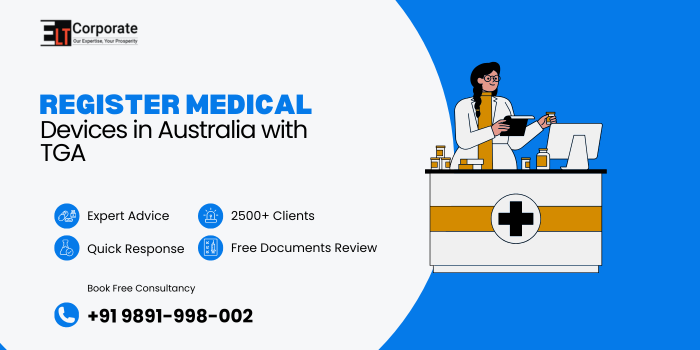If you want to sell or supply medical devices in Australia with TGA, you must first register them with the Therapeutic Goods Administration (TGA). The TGA is the national regulatory authority that ensures all medical devices meet safety, quality, and performance standards before they reach consumers.
Medical device registration with TGA is not just a paperwork process; it’s a vital step to ensure your product is compliant with Australian law and trusted by healthcare professionals and patients. Whether you’re a manufacturer, importer, or distributor, understanding this process helps you navigate compliance smoothly and avoid legal penalties.
What is the Role of TGA in Medical Device Regulation?
The Therapeutic Goods Administration (TGA) regulates medical devices under the Therapeutic Goods Act 1989. It ensures that all devices supplied in Australia are safe, effective, and of high quality.
The TGA’s key functions include:
- Assessing medical devices for compliance before registration.
- Conducting audits and inspections of manufacturers.
- Monitoring adverse event reports and recalls.
- Maintaining the Australian Register of Therapeutic Goods (ARTG) – a database of all approved medical devices.
Without TGA registration, no medical device can legally be imported, supplied, or marketed in Australia.
How Are Medical Devices Classified Under TGA Rules?
TGA classifies medical devices based on risk level – from low-risk (Class I) to high-risk (Class III and Active Implantable Devices).
- Class I – Low risk (e.g., bandages, reusable surgical instruments)
- Class Is / Im / AI – Special low-risk devices with sterile or measuring functions
- Class IIa – Moderate risk (e.g., dental fillings, ultrasound scanners)
- Class IIb – Medium to high risk (e.g., infusion pumps, ventilators)
- Class III / AIMD – High risk (e.g., pacemakers, heart valves, implants)
The higher the class, the more evidence and documentation you’ll need to submit to the TGA.
Who Can Apply for TGA Registration?
Only an Australian sponsor can apply for TGA registration.
A sponsor can be:
- The manufacturer’s local office in Australia, or
- An authorised representative or distributor located in Australia.
Overseas manufacturers must appoint a sponsor to manage registration and post-market activities on their behalf.
What Are the Steps to Register a Medical Device with TGA?
Here is a step-by-step guide to the TGA registration process for medical devices:
Step 1: Identify the Classification
Determine your device’s class based on risk level using Schedule 2 of the Therapeutic Goods (Medical Devices) Regulations 2002.
Step 2: Ensure Manufacturer Conformity Assessment
The manufacturer must hold a conformity assessment certificate, showing the device meets Essential Principles for safety, design, and performance.
If the device already holds CE Marking (EU approval), it may be accepted by TGA with supporting documentation.
Step 3: Appoint an Australian Sponsor
If you are not based in Australia, assign a local representative to handle communication with the TGA and maintain compliance.
Step 4: Create a TGA Business Account
Register an account on the TGA Business Services (TBS) portal to manage applications and payments.
Step 5: Submit Application to Include the Device in ARTG
The sponsor must submit an online application via TBS, providing:
- Device details and classification
- Manufacturer information
- Conformity assessment certificate
- Labeling and intended use
- Declaration of conformity
Step 6: TGA Review and Audit
The TGA may perform a pre-market audit (especially for higher-class devices). They verify technical documentation, safety data, and clinical evidence.
Step 7: Device Inclusion in ARTG
Once approved, your device will be listed in the Australian Register of Therapeutic Goods (ARTG), allowing you to legally import and sell it in Australia.
What Documents Are Required for TGA Registration?
To register a medical device with TGA, you must prepare:
- Declaration of Conformity (stating the device meets Essential Principles)
- Manufacturer’s Evidence (ISO 13485 certificate or CE Marking)
- Risk classification statement
- Technical documentation (design, performance, safety data)
- Labelling and Instructions for Use (IFU)
- Test reports and clinical data (for high-risk devices)
- Device GMDN code (Global Medical Device Nomenclature)
- Sponsor’s Declaration and business details
- Incomplete or inaccurate documentation can delay approval.
What Happens After TGA Registration?
Once a device is listed in the ARTG, the sponsor and manufacturer must:
Maintain compliance with Essential Principles at all times.
- Report adverse events or product recalls promptly.
- Keep up-to-date technical documentation.
- Cooperate with TGA audits and inspections.
- Renew and update certificates as required.
Failure to comply can result in suspension or cancellation of the ARTG entry.
What Are the Timelines and Fees for TGA Registration?
Timelines and fees depend on the device class:
- Class I: 2-4 weeks (self-declaration, minimal review)
- Class IIa & IIb: 3-6 months (may include audit)
- Class III & AIMD: 60-12 months (comprehensive review)
Updated fee schedules are available on the official TGA website.
What Are Common Challenges in TGA Medical Device Registration?
- Incorrect classification – leads to application rejection or resubmission.
- Incomplete manufacturer evidence – especially if no CE Marking.
- Unclear labelling or IFU – must match intended use.
- Slow communication – between overseas manufacturers and local sponsors.
- Changing regulations – as Australia updates its conformity rules regularly.
To overcome these, it’s best to work with compliance consultants familiar with TGA registration procedures.
How Long is TGA Registration Valid for?
TGA registration does not have an expiry date, but sponsors must maintain ongoing compliance and pay annual charges to keep ARTG entries active.
Can foreign manufacturers apply directly for TGA approval?
No, only an Australian-based sponsor can submit and manage TGA applications on behalf of foreign manufacturers.


Comments are closed